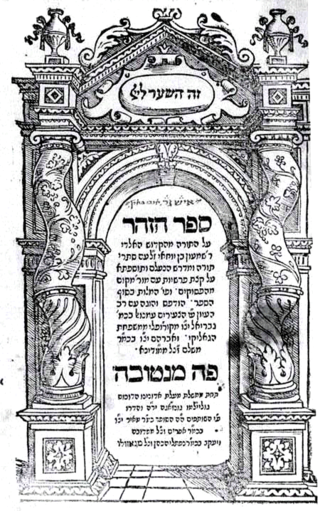Related Research Articles

The Zohar is a foundational work of Kabbalistic literature. It is a group of books including commentary on the mystical aspects of the Torah and scriptural interpretations as well as material on mysticism, mythical cosmogony, and mystical psychology. The Zohar contains discussions of the nature of God, the origin and structure of the universe, the nature of souls, redemption, the relationship of ego to darkness and "true self" to "the light of God".

The Tosafot,Tosafos or Tosfot are medieval commentaries on the Talmud. They take the form of critical and explanatory glosses, printed, in almost all Talmud editions, on the outer margin and opposite Rashi's notes.
Bahir or Sefer HaBahir is an anonymous mystical work, attributed to a 1st-century rabbinic sage Nehunya ben HaKanah because it begins with the words, "R. Nehunya ben HaKanah said". It is also known as Midrash of Rabbi Nehunya ben HaKanahמִדְרָשׁ רַבִּי נְחוּנְיָא בֶּן הַקָּנָה.
Chananel ben Chushiel or Ḥananel ben Ḥushiel, an 11th-century Kairouanan rabbi and Talmudist, was in close contact with the last Geonim. He is best known for his commentary on the Talmud. Chananel is often referred to as Rabbeinu Chananel – Hebrew for "our teacher, Chananel".

A maggid, also spelled as magid, is a traditional Jewish religious itinerant preacher, skilled as a narrator of Torah and religious stories. A chaplain of the more scholarly sort is called a darshan. The title of maggid mesharim probably dates from the sixteenth century.
Abraham ben David, also known by the abbreviation RABaDRavad or RABaD III, was a Provençal rabbi, an important commentator on the Talmud, Sefer Halachot of Rabbi Yitzhak Alfasi and Mishne Torah of Maimonides, and is regarded as a father of Kabbalah and one of the key links in the chain of Jewish mystics.
Mordechai ben Hillel HaKohen, also known as The Mordechai or, by some Sephardic scholars, as The Mordechie, was a 13th-century German rabbi and posek. His chief legal commentary on the Talmud, referred to as The Mordechai, is one of the sources of the Shulchan Aruch. He was killed in the Rintfleisch massacres in 1298.
Tobiah ben Eliezer was a Talmudist and poet of the 11th century, author of Lekach Tov or Pesikta Zutarta, a midrashic commentary on the Pentateuch and the Five Megillot.
Isaac ben Abba Mari was a Provençal rabbi who hailed from Marseilles. He is often simply referred to as "Ba'al ha-Ittur," after his Magnum opus, Ittur Soferim.

Sifra is the Midrash halakha to the Book of Leviticus. It is frequently quoted in the Talmud and the study of it followed that of the Mishnah. Like Leviticus itself, the midrash is occasionally called Torat Kohanim, and in two passages Sifra debbe Rav.

Sifre refers to either of two works of Midrash halakha, or classical Jewish legal biblical exegesis, based on the biblical books of Numbers and Deuteronomy.
Tamid is the ninth tractate in Kodashim, which is the fifth of the six orders of the Mishnah, Tosefta, and the Talmud.

Kil'ayim is the fourth tractate of Seder Zeraim of the Mishnah, dealing with several biblical prohibitions of mixed species, namely, planting certain mixtures of seeds, grafting different species of trees together, growing plants other than grapevines in vineyards, crossbreeding animals, working a team of different kinds of animals together, and mixing wool and linen in garments.
Simeon ben Zemah Duran, also Tzemach Duran, known as Rashbatz (רשב"ץ) or Tashbatz, was a Rabbinical authority, student of philosophy, astronomy, mathematics, and especially of medicine, which he practised for a number of years at Palma de Mallorca. A major 15th century posek, his published decisions in matters of halakha have been widely quoted in halakhic literature for hundreds of years.

Pirkei de-Rabbi Eliezer is an aggadic-midrashic work on the Torah containing exegesis and retellings of biblical stories. Traditionaly, the work is attributed to the Tanna Rabbi Eliezer ben Hyrcanus and his school, but research suggests it is a pseudepigraphic work from the Geonic period, written in the eighth century in or around the Land of Israel.

The Baraita on the Thirty-two Rules or Baraita of R. Eliezer ben Jose ha-Gelili is a baraita giving 32 hermeneutic rules, or middot, for interpreting the Bible. As of when the Jewish Encyclopedia was published in 1901–1906, it was thought to no longer exist except in references by later authorities. However, it was discovered in 1933 by H. G. Enelow, who published it in his "Mishnat Rabbi Eliezer," and in 1947 it was published again in Margaliot's edition of Midrash Hagadol to Genesis.

Shir haShirim Zutta is a midrash on Shir haShirim.
Jewish printers were quick to take advantages of the printing press in publishing the Hebrew Bible. While for synagogue services written scrolls were used, the printing press was very soon called into service to provide copies of the Hebrew Bible for private use. All the editions published before the Complutensian Polyglot were edited by Jews; but afterwards, and because of the increased interest excited in the Bible by the Reformation, the work was taken up by Christian scholars and printers; and the editions published by Jews after this time were largely influenced by these Christian publications. It is not possible in the present article to enumerate all the editions, whole or partial, of the Hebrew text. This account is devoted mainly to the incunabula.
Rabbi Meir ben Solomon Abi-Sahula also known as ben Sahula or ibn Sahula was a 13th century Spanish kabbalist and Sephardic tosafist. He is known for his final commentary on Sefer Bahir, which he published under the pseudonym "Or HaGanuz".
References
- ↑ Scholem, Gerschom (2017). Sabbatai Ṣevi – The Mystical Messiah, 1626–1676. Princeton: Princeton University Press. p. 84.